Parsing PHP8 underlying kernel source code - array (4)
This article introduces to you "Analysis of PHP8 underlying kernel source code - array (4)". It has certain reference value. Friends in need can refer to it. I hope it will be helpful to everyone.
Recommended related articles: "Analysis of PHP8 underlying kernel source code - array (1) " "Analysis of PHP8 underlying kernel source code - array (2) " " Parsing PHP8 underlying kernel source code - array (3) 》
In Runningprocess, we already know that the code needs to go through lexical analysis, syntax analysis, compilation and execution of four major steps
PHP 8 will create an array constant during the compilation phase (when the AST abstract syntax tree is compiled into opcode). This array constant, like numeric constants and string constants, is determined and allocated memory during the compilation phase. So the initialization of the array happens during the compilation phase.
PHP’s array initialization code part is as follows
//如果开启zend_debug
#if !ZEND_DEBUG && defined(HAVE_BUILTIN_CONSTANT_P)
# define zend_new_array(size) \
(__builtin_constant_p(size) ? \
((((uint32_t)(size)) <= HT_MIN_SIZE) ? \
_zend_new_array_0() \
//走 _zend_new_array_0
: \
_zend_new_array((size)) \
) \
: \
_zend_new_array((size)) \
)
#else
//没有开启 也就是一般模式 走 _zend_new_array
# define zend_new_array(size) \
_zend_new_array(size)
#endif
ZEND_API void ZEND_FASTCALL _zend_hash_init(HashTable *ht, uint32_t nSize, dtor_func_t pDestructor, zend_bool persistent)
{
_zend_hash_init_int(ht, nSize, pDestructor, persistent);
}
ZEND_API HashTable* ZEND_FASTCALL _zend_new_array_0(void)
{ //分配内存空间
HashTable *ht = emalloc(sizeof(HashTable));
//初始化
_zend_hash_init_int(ht, HT_MIN_SIZE, ZVAL_PTR_DTOR, 0);
return ht;
}
//初始化方法
static zend_always_inline void _zend_hash_init_int(HashTable *ht, uint32_t nSize, dtor_func_t pDestructor, zend_bool persistent)
{
GC_SET_REFCOUNT(ht, 1);
GC_TYPE_INFO(ht) = GC_ARRAY | (persistent ? ((GC_PERSISTENT|GC_NOT_COLLECTABLE) << GC_FLAGS_SHIFT) : 0);
HT_FLAGS(ht) = HASH_FLAG_UNINITIALIZED;
ht->nTableMask = HT_MIN_MASK;
HT_SET_DATA_ADDR(ht, &uninitialized_bucket);
ht->nNumUsed = 0;
ht->nNumOfElements = 0;
ht->nInternalPointer = 0;
ht->nNextFreeElement = ZEND_LONG_MIN;
ht->pDestructor = pDestructor;
ht->nTableSize = zend_hash_check_size(nSize);
}
//初始化 bucket 也就是 ardata
ZEND_API void ZEND_FASTCALL zend_hash_real_init(HashTable *ht, zend_bool packed)
{
IS_CONSISTENT(ht);
HT_ASSERT_RC1(ht);
//调用 zend_hash_real_init_ex方法
zend_hash_real_init_ex(ht, packed);
}
//zend_hash_real_init_ex方法
static zend_always_inline void zend_hash_real_init_ex(HashTable *ht, bool packed)
{
HT_ASSERT_RC1(ht);
ZEND_ASSERT(HT_FLAGS(ht) & HASH_FLAG_UNINITIALIZED);
if (packed) {
//如果是packed_array
zend_hash_real_init_packed_ex(ht);
} else {
//如果是 hash_array
zend_hash_real_init_mixed_ex(ht);
}
}
//paced_array 初始化bucket 的代码
static zend_always_inline void zend_hash_real_init_packed_ex(HashTable *ht)
{
void *data;
if (UNEXPECTED(GC_FLAGS(ht) & IS_ARRAY_PERSISTENT)) {
data = pemalloc(HT_SIZE_EX(ht->nTableSize, HT_MIN_MASK), 1);
} else if (EXPECTED(ht->nTableSize == HT_MIN_SIZE)) {
data = emalloc(HT_SIZE_EX(HT_MIN_SIZE, HT_MIN_MASK));
} else {
data = emalloc(HT_SIZE_EX(ht->nTableSize, HT_MIN_MASK));
}
HT_SET_DATA_ADDR(ht, data);
/* Don't overwrite iterator count. */
ht->u.v.flags = HASH_FLAG_PACKED | HASH_FLAG_STATIC_KEYS;
HT_HASH_RESET_PACKED(ht);
}
//hash_array 初始化bucket的代码
static zend_always_inline void zend_hash_real_init_mixed_ex(HashTable *ht)
{
void *data;
uint32_t nSize = ht->nTableSize;
if (UNEXPECTED(GC_FLAGS(ht) & IS_ARRAY_PERSISTENT)) {
data = pemalloc(HT_SIZE_EX(nSize, HT_SIZE_TO_MASK(nSize)), 1);
} else if (EXPECTED(nSize == HT_MIN_SIZE)) {
data = emalloc(HT_SIZE_EX(HT_MIN_SIZE, HT_SIZE_TO_MASK(HT_MIN_SIZE)));
ht->nTableMask = HT_SIZE_TO_MASK(HT_MIN_SIZE);
HT_SET_DATA_ADDR(ht, data);
/* Don't overwrite iterator count. */
ht->u.v.flags = HASH_FLAG_STATIC_KEYS;
#ifdef __SSE2__
do {
__m128i xmm0 = _mm_setzero_si128();
xmm0 = _mm_cmpeq_epi8(xmm0, xmm0);
_mm_storeu_si128((__m128i*)&HT_HASH_EX(data, 0), xmm0);
_mm_storeu_si128((__m128i*)&HT_HASH_EX(data, 4), xmm0);
_mm_storeu_si128((__m128i*)&HT_HASH_EX(data, 8), xmm0);
_mm_storeu_si128((__m128i*)&HT_HASH_EX(data, 12), xmm0);
} while (0);
#elif defined(__aarch64__)
do {
int32x4_t t = vdupq_n_s32(-1);
vst1q_s32((int32_t*)&HT_HASH_EX(data, 0), t);
vst1q_s32((int32_t*)&HT_HASH_EX(data, 4), t);
vst1q_s32((int32_t*)&HT_HASH_EX(data, 8), t);
vst1q_s32((int32_t*)&HT_HASH_EX(data, 12), t);
} while (0);
#else
HT_HASH_EX(data, 0) = -1;
HT_HASH_EX(data, 1) = -1;
HT_HASH_EX(data, 2) = -1;
HT_HASH_EX(data, 3) = -1;
HT_HASH_EX(data, 4) = -1;
HT_HASH_EX(data, 5) = -1;
HT_HASH_EX(data, 6) = -1;
HT_HASH_EX(data, 7) = -1;
HT_HASH_EX(data, 8) = -1;
HT_HASH_EX(data, 9) = -1;
HT_HASH_EX(data, 10) = -1;
HT_HASH_EX(data, 11) = -1;
HT_HASH_EX(data, 12) = -1;
HT_HASH_EX(data, 13) = -1;
HT_HASH_EX(data, 14) = -1;
HT_HASH_EX(data, 15) = -1;
#endif
return;
} else {
data = emalloc(HT_SIZE_EX(nSize, HT_SIZE_TO_MASK(nSize)));
}
ht->nTableMask = HT_SIZE_TO_MASK(nSize);
HT_SET_DATA_ADDR(ht, data);
HT_FLAGS(ht) = HASH_FLAG_STATIC_KEYS;
HT_HASH_RESET(ht);
}
//数组赋值和更新值
static zend_always_inline zval *_zend_hash_index_add_or_update_i(HashTable *ht, zend_ulong h, zval *pData, uint32_t flag)
{
uint32_t nIndex;
uint32_t idx;
Bucket *p;
IS_CONSISTENT(ht);
HT_ASSERT_RC1(ht);
if ((flag & HASH_ADD_NEXT) && h == ZEND_LONG_MIN) {
h = 0;
}
if (HT_FLAGS(ht) & HASH_FLAG_PACKED) {
if (h < ht->nNumUsed) {
p = ht->arData + h;
if (Z_TYPE(p->val) != IS_UNDEF) {
replace:
if (flag & HASH_ADD) {
return NULL;
}
if (ht->pDestructor) {
ht->pDestructor(&p->val);
}
ZVAL_COPY_VALUE(&p->val, pData);
return &p->val;
} else { /* we have to keep the order :( */
goto convert_to_hash;
}
} else if (EXPECTED(h < ht->nTableSize)) {
add_to_packed:
p = ht->arData + h;
/* incremental initialization of empty Buckets */
if ((flag & (HASH_ADD_NEW|HASH_ADD_NEXT)) != (HASH_ADD_NEW|HASH_ADD_NEXT)) {
if (h > ht->nNumUsed) {
Bucket *q = ht->arData + ht->nNumUsed;
while (q != p) {
ZVAL_UNDEF(&q->val);
q++;
}
}
}
ht->nNextFreeElement = ht->nNumUsed = h + 1;
goto add;
} else if ((h >> 1) < ht->nTableSize &&
(ht->nTableSize >> 1) < ht->nNumOfElements) {
zend_hash_packed_grow(ht);
goto add_to_packed;
} else {
if (ht->nNumUsed >= ht->nTableSize) {
ht->nTableSize += ht->nTableSize;
}
convert_to_hash:
zend_hash_packed_to_hash(ht);
}
} else if (HT_FLAGS(ht) & HASH_FLAG_UNINITIALIZED) {
if (h < ht->nTableSize) {
zend_hash_real_init_packed_ex(ht);
goto add_to_packed;
}
zend_hash_real_init_mixed(ht);
} else {
if ((flag & HASH_ADD_NEW) == 0 || ZEND_DEBUG) {
p = zend_hash_index_find_bucket(ht, h);
if (p) {
ZEND_ASSERT((flag & HASH_ADD_NEW) == 0);
goto replace;
}
}
ZEND_HASH_IF_FULL_DO_RESIZE(ht);/* If the Hash table is full, resize it */
}
idx = ht->nNumUsed++;
nIndex = h | ht->nTableMask;
p = ht->arData + idx;
Z_NEXT(p->val) = HT_HASH(ht, nIndex);
HT_HASH(ht, nIndex) = HT_IDX_TO_HASH(idx);
if ((zend_long)h >= ht->nNextFreeElement) {
ht->nNextFreeElement = (zend_long)h < ZEND_LONG_MAX ? h + 1 : ZEND_LONG_MAX;
}
add:
ht->nNumOfElements++;
p->h = h;
p->key = NULL;
ZVAL_COPY_VALUE(&p->val, pData);
return &p->val;
}_zend_hash_init_int The flow chart is as follows
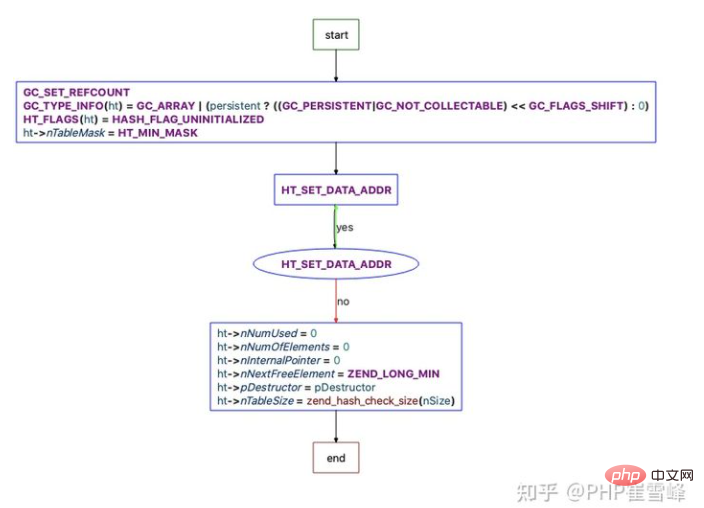
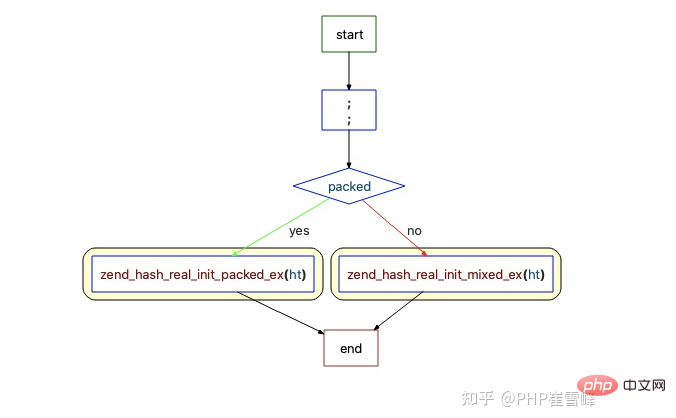 ##zend_hash_real_init_ex method flow chart (initializing bucket)
##zend_hash_real_init_ex method flow chart (initializing bucket)
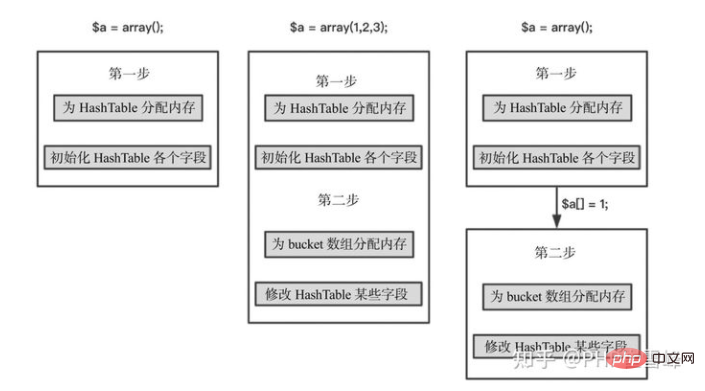
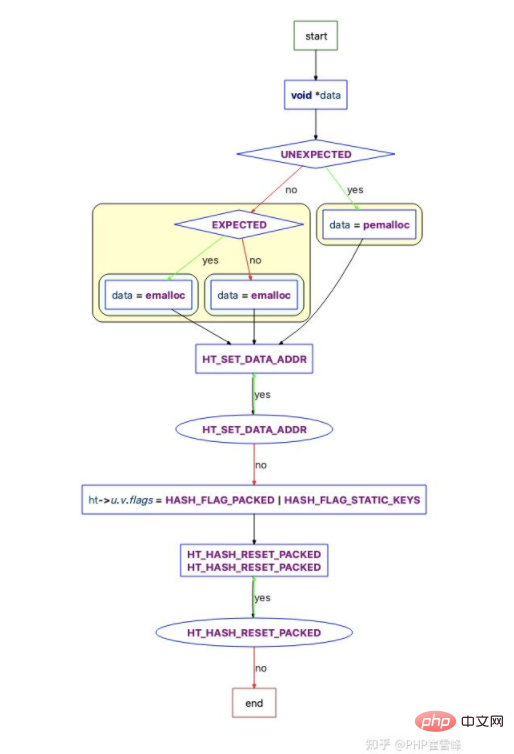
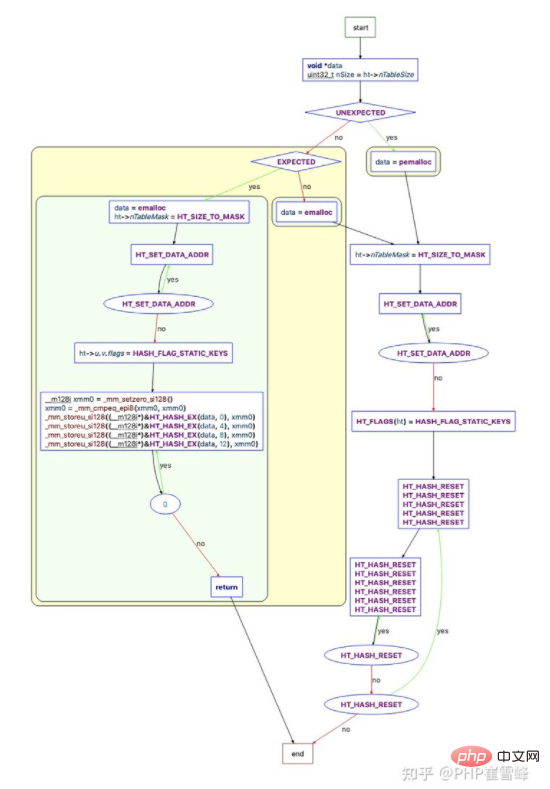
The above is the detailed content of Parsing PHP8 underlying kernel source code - array (4). For more information, please follow other related articles on the PHP Chinese website!

Hot AI Tools

Undresser.AI Undress
AI-powered app for creating realistic nude photos

AI Clothes Remover
Online AI tool for removing clothes from photos.

Undress AI Tool
Undress images for free

Clothoff.io
AI clothes remover

AI Hentai Generator
Generate AI Hentai for free.

Hot Article

Hot Tools

Notepad++7.3.1
Easy-to-use and free code editor

SublimeText3 Chinese version
Chinese version, very easy to use

Zend Studio 13.0.1
Powerful PHP integrated development environment

Dreamweaver CS6
Visual web development tools

SublimeText3 Mac version
God-level code editing software (SublimeText3)

Hot Topics
 How to remove duplicate elements from PHP array using foreach loop?
Apr 27, 2024 am 11:33 AM
How to remove duplicate elements from PHP array using foreach loop?
Apr 27, 2024 am 11:33 AM
The method of using a foreach loop to remove duplicate elements from a PHP array is as follows: traverse the array, and if the element already exists and the current position is not the first occurrence, delete it. For example, if there are duplicate records in the database query results, you can use this method to remove them and obtain results without duplicate records.
 PHP array key value flipping: Comparative performance analysis of different methods
May 03, 2024 pm 09:03 PM
PHP array key value flipping: Comparative performance analysis of different methods
May 03, 2024 pm 09:03 PM
The performance comparison of PHP array key value flipping methods shows that the array_flip() function performs better than the for loop in large arrays (more than 1 million elements) and takes less time. The for loop method of manually flipping key values takes a relatively long time.
 The Art of PHP Array Deep Copy: Using Different Methods to Achieve a Perfect Copy
May 01, 2024 pm 12:30 PM
The Art of PHP Array Deep Copy: Using Different Methods to Achieve a Perfect Copy
May 01, 2024 pm 12:30 PM
Methods for deep copying arrays in PHP include: JSON encoding and decoding using json_decode and json_encode. Use array_map and clone to make deep copies of keys and values. Use serialize and unserialize for serialization and deserialization.
 PHP array multi-dimensional sorting practice: from simple to complex scenarios
Apr 29, 2024 pm 09:12 PM
PHP array multi-dimensional sorting practice: from simple to complex scenarios
Apr 29, 2024 pm 09:12 PM
Multidimensional array sorting can be divided into single column sorting and nested sorting. Single column sorting can use the array_multisort() function to sort by columns; nested sorting requires a recursive function to traverse the array and sort it. Practical cases include sorting by product name and compound sorting by sales volume and price.
 Application of PHP array grouping function in data sorting
May 04, 2024 pm 01:03 PM
Application of PHP array grouping function in data sorting
May 04, 2024 pm 01:03 PM
PHP's array_group_by function can group elements in an array based on keys or closure functions, returning an associative array where the key is the group name and the value is an array of elements belonging to the group.
 Best Practices for Deep Copying PHP Arrays: Discover Efficient Methods
Apr 30, 2024 pm 03:42 PM
Best Practices for Deep Copying PHP Arrays: Discover Efficient Methods
Apr 30, 2024 pm 03:42 PM
The best practice for performing an array deep copy in PHP is to use json_decode(json_encode($arr)) to convert the array to a JSON string and then convert it back to an array. Use unserialize(serialize($arr)) to serialize the array to a string and then deserialize it to a new array. Use the RecursiveIteratorIterator to recursively traverse multidimensional arrays.
 The role of PHP array grouping function in finding duplicate elements
May 05, 2024 am 09:21 AM
The role of PHP array grouping function in finding duplicate elements
May 05, 2024 am 09:21 AM
PHP's array_group() function can be used to group an array by a specified key to find duplicate elements. This function works through the following steps: Use key_callback to specify the grouping key. Optionally use value_callback to determine grouping values. Count grouped elements and identify duplicates. Therefore, the array_group() function is very useful for finding and processing duplicate elements.
 PHP array merging and deduplication algorithm: parallel solution
Apr 18, 2024 pm 02:30 PM
PHP array merging and deduplication algorithm: parallel solution
Apr 18, 2024 pm 02:30 PM
The PHP array merging and deduplication algorithm provides a parallel solution, dividing the original array into small blocks for parallel processing, and the main process merges the results of the blocks to deduplicate. Algorithmic steps: Split the original array into equally allocated small blocks. Process each block for deduplication in parallel. Merge block results and deduplicate again.






